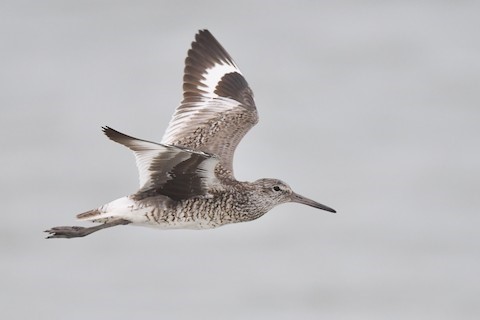Birdfinding.info ⇒ The eastern form of the Willet is generally common on beaches along the Atlantic and Gulf coasts of the U.S. and Caribbean. However, its distribution is poorly understood due to inconsistent identification of the eastern and western forms in their extensive areas of overlap. During the boreal winter, the “Eastern Willet” becomes locally common along the Atlantic coast of South America south to northeastern Brazil.
“Eastern Willet”
Tringa semipalmata semipalmata
Breeds along coasts of eastern North America and the West Indies. Winters along coasts from the eastern U.S. to Brazil.

Approximate distribution of the Willet (includes both “Western” and “Eastern” forms). © BirdLife International 2016
Breeding. Nests in saltmarshes along the Atlantic coast from the Gaspé Peninsula and Cape Breton south to Florida, and the Gulf of Mexico coast from Tamaulipas to Florida.
In the West Indies, it breeds locally in the Bahamas, Cuba, the Cayman Islands, Jamaica, Hispaniola, Puerto Rico, and the Virgin and Leeward Islands east to Barbuda.
There is at least one historical breeding record from the Los Roques archipelago of Venezuela, but it is not known to breed there regularly.
Nonbreeding. Winters along coasts of the Atlantic, Gulf of Mexico, and Caribbean, regularly north to Virginia and south to eastern Brazil. Substantial flocks winter south at least as far as Sergipe, and progressively smaller numbers spread south along the full extent of Brazil’s coastline to Rio Grande do Sul, with a few stragglers reaching Buenos Aires Province, Argentina.
The “Eastern Willet” has also been reported in winter along the Pacific coast of Middle America—although difficulty in consistently separating the “Eastern” and “Western” forms in nonbreeding plumages leaves most such records in doubt.
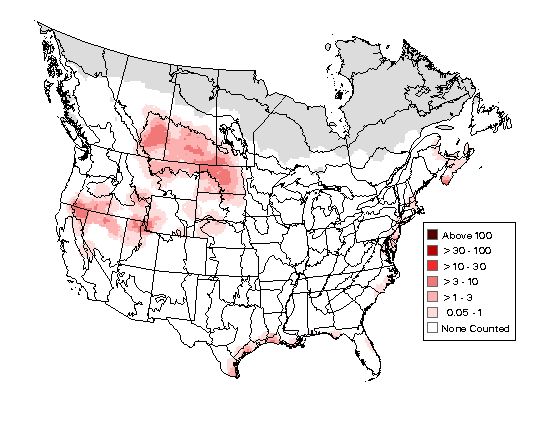
Breeding Bird Survey Abundance Map: Willet (includes both “Western” and “Eastern” forms). U.S. Geological Survey 2015
The northern extent of its wintering range is poorly understood due to the presence of nonbreeding “Western Willets” throughout most of the “Eastern Willet’s” breeding range.
Movements. The migratory patterns of the “Eastern Willet” are also poorly understood due to the challenge of distinguishing it from “Western”, combined with the fact that many individuals of both forms apparently remain on large portions of the “Eastern Willet’s” breeding and wintering grounds year-round.
A substantial portion of the “Eastern” population moves far south during the boreal winter, vacating the northern temperate zone and flying to the West Indies and coasts of northern and eastern South America.
Northbound migration results in regular spring overshoots to the coasts of Newfoundland and the St. Lawrence corridor of Quebec, and irregularly farther inland—a handful of the Willets reported from the Great Lakes area have been attributed to the “Eastern” form.
Dispersal of post-breeding adults and juveniles from July to September contributes additional records from generally the same areas of eastern Canada, a few occasionally (or perhaps annually) reach Bermuda.
Identification
A large, heavy-bodied, thick-billed tringine sandpiper with grayish legs and a bold black-and-white striped pattern on the wings that is visible mainly in flight. Distinctive, except that it is nearly identical to the “Western Willet”. The two forms can often be distinguished by subtle differences in coloration, pattern, structure, size, and voice.
“Eastern” averages darker and browner (less gray) than “Western” in all plumages, and averages about 10-15% shorter than “Western” in most measurements, including the bill and legs, but much less massive.

“Eastern Willet”, T. s. semipalmata, in nonbreeding plumage, showing bold black-and-white-wingstripe pattern. (São Gonçalo do Amarante, Ceará, Brazil; October 15, 2021.) © Sandra Rebello
Both forms are immediately recognizable as Willets when they take flight because their wings are dominated above and below by flashy, black-and-white stripes.
Apart from the bold wing pattern, Willet plumage is generally nondescript: pale grayish or brownish-gray overall, with whiter underparts. Willets are usually encountered on beaches, where they blend into the sandy or muddy habitat.

“Eastern Willet”, T. s. semipalmata, in nonbreeding plumage. (Jandaíra, Bahia, Brazil; November 7, 2015.) © Ester Ramirez
In size and shape, Willets are roughly intermediate between various other tringine sandpipers, which are tall, thin, and long-legged, and the larger, heavier, longer-billed godwits and dowitchers. Willets often flock with all of these relatives. They are heavier than the other tringines and thinner and shorter-billed than godwits and dowitchers.
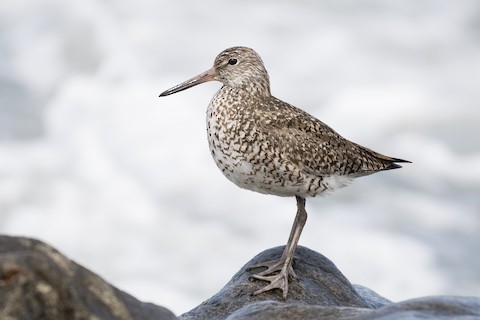
“Eastern Willet”, T. s. semipalmata, in breeding plumage, showing its partly webbed toes. (Morden, Nova Scotia; May 11, 2021.) © Lyall Bouchard
A Willet’s bill is longer than the head, but usually less than two times its length. The bill usually appears subtly bicolored, blackish on the outer half and pale, fleshy or grayish, near the base. The “Eastern Willet’s” bill usually appears straight, but a few are slightly upturned (this shape is more typical of “Western”).
Willet legs are fairly long, as in other Tringas, but thicker, with partially webbed toes that are readily visible if seen clearly. The legs are usually grayish, but sometimes appear yellowish or greenish.
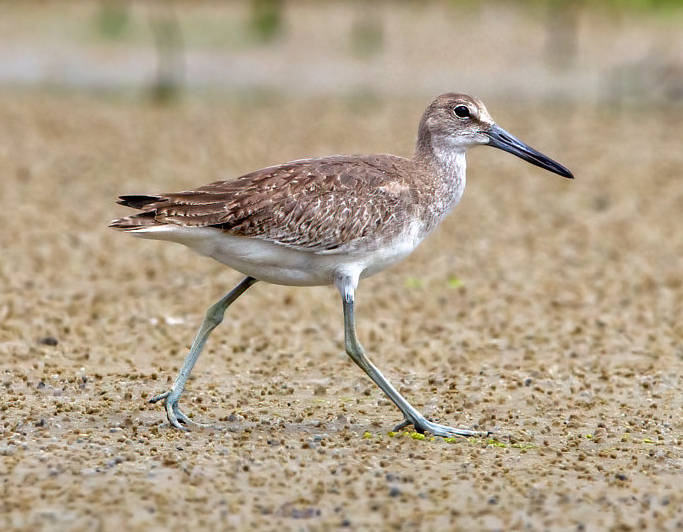
“Eastern Willet”, T. s. semipalmata, juvenile. (Florianópolis, Santa Catarina, Brazil; October 10, 2021.) © Fernando Farias

“Eastern Willet”, T. s. semipalmata, in breeding plumage. (Scarborough Marsh, Scarborough, Maine; June 11, 2021.) © Gerry Hawkins
In breeding plumage, the “Eastern Willet” becomes densely marked with dark-brown streaks, spots, scallops, and bars.
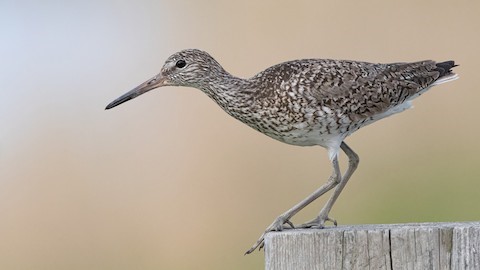
“Eastern Willet”, T. s. semipalmata, in breeding plumage. (Parker River National Wildlife Refuge, Massachusetts; May 19, 2021.) © Sam Zhang
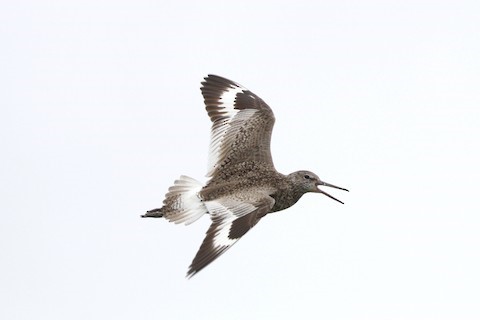
“Eastern Willet”, T. s. semipalmata, in breeding plumage. (Lawrencetown Provincial Park, Nova Scotia; July 25, 2017.) © Aaron Marshall

“Eastern Willet”, T. s. semipalmata, in breeding plumage. (Hundred Acre Cove, Rhode Island; June 21, 2017.) © Evan Lipton
In nonbreeding plumage, both Willet forms are mostly grayish above and white below, but “Eastern” tends to appear slightly darker and browner above. (Contrary to some references, on both forms the white of the underparts often extends up the chest to the throat—this does not distinguish the forms.)

“Eastern Willet”, T. s. semipalmata, in nonbreeding plumage. (Parque Morro da Pescaria, Guarapari, Espírito Santo, Brazil; December 28, 2021.) © Celso Modesto Jr.

“Eastern Willet”, T. s. semipalmata, in nonbreeding plumage. (Vitória, Espírito Santo, Brazil; November 28, 2016.) © Eduardo S. Neves
The juvenile “Eastern Willet” has largely brownish upperparts with conspicuous pale spots along the edges of its brown feathers.
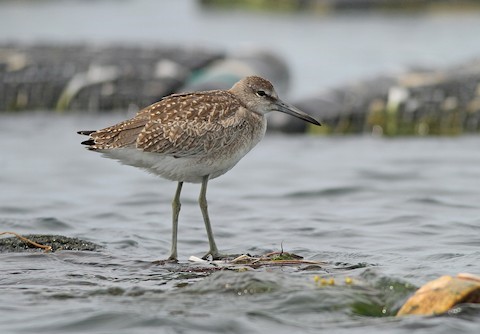
“Eastern Willet”, T. s. semipalmata, juvenile. (Nauset Marsh, Eastham, Massachusetts; September 3, 2016.) © Jeremiah Trimble

“Eastern Willet”, T. s. semipalmata, juvenile. (Portsmouth Island, Cape Lookout National Seashore, North Carolina; July 11, 2020.) © Daniel Irons
Voice. Most calls of the “Eastern Willet” resemble equivalent calls of “Western”, but are higher-pitched. Typical contact calls include a sharp, squeaky kip!, often repeated: The song given on the breeding grounds, often in flight, is usually rendered as “pilly-will-willet”: Other calls include an excited, seemingly compulsive chatter:And rolling trills:
Notes
Monotypic form, one of two potentially distinct forms of Willet (Tringa semipalmata), which was formerly accorded its own genus, Catoptrophorus.
More Images of the “Eastern Willet”

“Eastern Willet”, T. s. semipalmata, in breeding plumage. (Falkner Island, Connecticut; July 11, 2019.) © Andy Eckerson

“Eastern Willet”, T. s. semipalmata, in nonbreeding plumage. (Vitória, Espírito Santo, Brazil; November 26, 2016.) © Gil Ribeiro Peres

“Eastern Willet”, T. s. semipalmata, in breeding plumage. (Merritt Island National Wildlife Refuge, Florida; May 13, 2020.) © Alan Wells
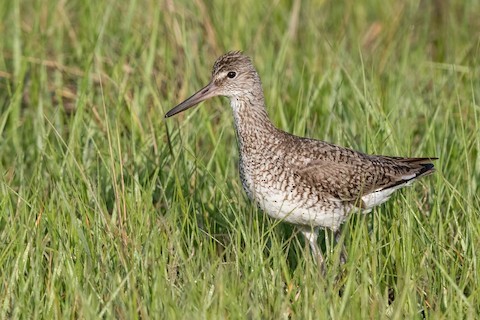
“Eastern Willet”, T. s. semipalmata, in breeding plumage. (Parker River National Wildlife Refuge, Massachusetts; June 10, 2021.) © Sam Zhang
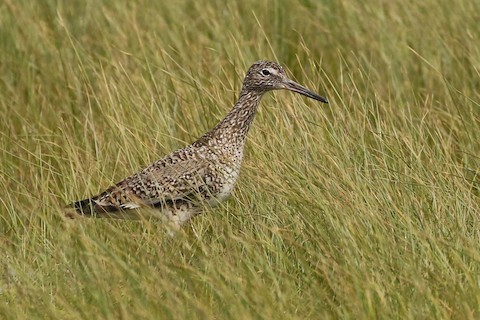
“Eastern Willet”, T. s. semipalmata, in breeding plumage. (Squantum Marshes, Quincy, Massachusetts; May 11, 2020.) © Jeffrey Offermann

“Eastern Willet”, T. s. semipalmata, in breeding plumage. (Parker River National Wildlife Refuge, Massachusetts; May 19, 2021.) © Sam Zhang

“Eastern Willet”, T. s. semipalmata, in breeding plumage. (Parker River National Wildlife Refuge, Massachusetts; June 10, 2021.) © Sam Zhang

“Eastern Willet”, T. s. semipalmata, in breeding plumage. (Scarborough Marsh, Scarborough, Maine; May 8, 2014.) © Margaret Viens
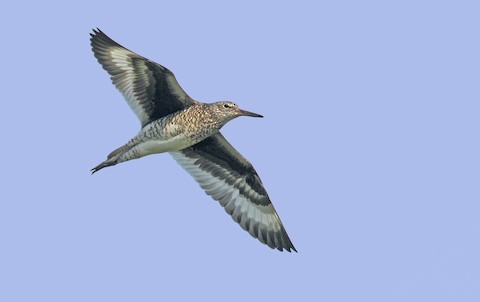
“Eastern Willet”, T. s. semipalmata, in breeding plumage. (Ridgevale Beach, Chatham, Massachusetts; June 9, 2013.) © Ryan Schain

“Eastern Willet”, T. s. semipalmata, juvenile in flight, showing black-and-white stripes on upperwing and underwing. (Portsmouth Island, Cape Lookout National Seashore, North Carolina; July 11, 2020.) © Daniel Irons
References
Alderfer, J., and J.L. Dunn. 2014. National Geographic Complete Birds of North America (Second Edition). National Geographic Society, Washington, D.C.
Ascanio, D., G.A. Rodriguez, and R. Restall. 2017. Birds of Venezuela. Christopher Helm, London.
BirdLife International. 2016. Tringa semipalmata. The IUCN Red List of Threatened Species 2016: e.T22693319A93395925. https://dx.doi.org/10.2305/IUCN.UK.2016-3.RLTS.T22693319A93395925.en. (Accessed May 3, 2022.)
Chandler, R. 2009. Shorebirds of North America, Europe, and Asia: A Photographic Guide. Princeton University Press.
eBird. 2022. eBird: An online database of bird distribution and abundance. Cornell Lab of Ornithology, Ithaca, N.Y. http://www.ebird.org. (Accessed May 3, 2022.)
Fagan, J., and O. Komar. 2016. Peterson Field Guide to the Birds of Northern Central America. Houghton Mifflin Harcourt, New York.
ffrench, R. 2012. A Guide to the Birds of Trinidad & Tobago (Third Edition). Cornell University Press.
Garcia-del-Rey, E. 2011. Field Guide to the Birds of Macaronesia: Azores, Madeira, Canary Islands, Cape Verde. Lynx Editions, Barcelona.
Garrigues, R., and R. Dean. 2014. The Birds of Costa Rica: A Field Guide (Second Edition). Cornell University Press.
Haynes-Sutton, A., A. Downer, R. Sutton, and Y.-J. Rey-Millet. 1986. A Photographic Guide to the Birds of Jamaica. Princeton University Press.
Howell, S.N.G., and S. Webb. 1995. A Guide to the Birds of Mexico and Northern Central America. Oxford University Press.
Kirwan, G.M., A. Levesque, M. Oberle, and C.J. Sharpe. 2019. Birds of the West Indies. Lynx Edicions, Barcelona.
Latta, S., C. Rimmer, A. Keith, J. Wiley, H. Raffaele, K. McFarland, and E. Fernandez. 2006. Birds of the Dominican Republic and Haiti. Princeton University Press.
Marchant, J., T. Prater, and P. Hayman. 1986. Shorebirds: An Identification Guide to the Waders of the World. Houghton Mifflin, Boston.
McMullan, M., and T. Donegan. 2014, Field Guide to the Birds of Colombia (Second Edition). Fundación Proaves de Colombia, Bogotá.
Message, S., and D. Taylor. 2005. Shorebirds of North America, Europe, and Asia: A Guide to Field Identification. Princeton University Press.
Oswald, J.A., M.G. Harvey, R.C. Remsen, D.P.U. Foxworth, S.W. Cardiff, D.L. Dittmann, L.C. Megna, M.D. Carling, and R.T. Brumfield. 2016. Willet Be One Species or Two? A Genomic View of the Evolutionary History of Tringa semipalmata. Auk, 133:593-614.
Paulson, D. 2005. Shorebirds of North America: The Photographic Guide. Princeton University Press.
Pyle, R.L., and P. Pyle. 2017. The Birds of the Hawaiian Islands: Occurrence, History, Distribution, and Status. Version 2 (January 1, 2017). http://hbs.bishopmuseum.org/birds/rlp-monograph/. B.P. Bishop Museum, Honolulu, Hawaii.
Raffaele, H., J. Wiley, O. Garrido, A. Keith, and J. Raffaele. 1998. A Guide to the Birds of the West Indies. Princeton University Press.
Ridgely, R.S., and P.J. Greenfield. 2001. The Birds of Ecuador, Volume II: Field Guide. Cornell University Press.
Ridgely, R.S., and J.A. Gwynne. 1989. A Guide to the Birds of Panama (Second Edition). Princeton University Press.
Schulenberg, T.S., D.F. Stotz, D.F. Lane, J.P. O’Neill, and T.A. Parker. 2007. Birds of Peru. Princeton University Press.
Sibley, D.A. 2014. The Sibley Guide to Birds (Second Edition). Alfred A. Knopf. New York.
Stiles, F.G., A.F. Skutch, and D. Gardner. 1989. A Guide to the Birds of Costa Rica. Cornell University Press.
Svensson, L., K. Mullarney, and D. Zetterström. 2009. Birds of Europe (Second Edition). Princeton University Press.
van Perlo, B. 2009. A Field Guide to the Birds of Brazil. Oxford University Press.
Wells, J.V., and A.C. Wells. 2017. Birds of Aruba, Bonaire, and Curaçao. Cornell University Press.
Wikiaves. 2022. Maçarico-de-asa-branca, https://www.wikiaves.com.br/wiki/macarico-de-asa-branca. (Accessed May 3, 2022.)
Xeno-Canto. 2022. Willet – Tringa semipalmata, https://xeno-canto.org/species/Tringa-semipalmata. (Accessed May 3, 2022.)
